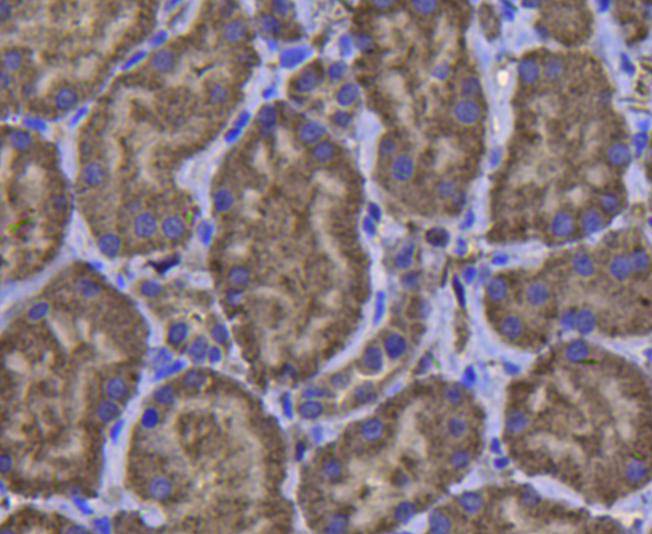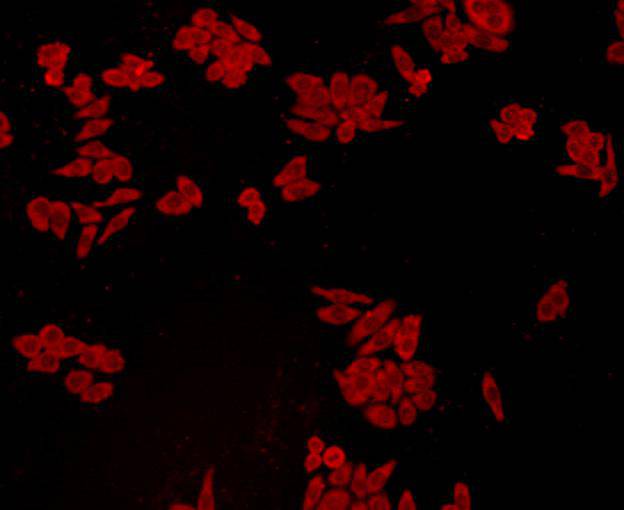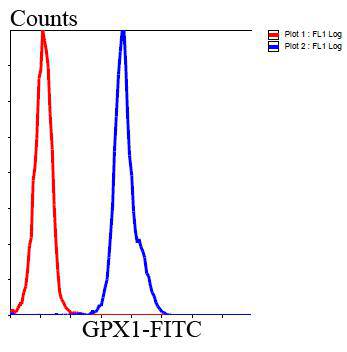Product Detail
Product NameGlutathione Peroxidase 1 Antibody
Clone No.C5-F6
Host SpeciesMouse
ClonalityMonoclonal
PurificationProA affinity purified
ApplicationsWB, ICC, IHC, FC
Species ReactivityHu
Immunogen Descrecombinant protein
ConjugateUnconjugated
Other NamesAL033363 antibody
Cellular glutathione peroxidase antibody
Glutathione peroxidase 1 antibody
Glutathione peroxidase antibody
GPx 1 antibody
GPx-1 antibody
GPX1 antibody
GPX1_HUMAN antibody
GPXD antibody
GSHPx-1 antibody
GSHPX1 antibody
MGC14399 antibody
MGC88245 antibody
Accession NoSwiss-Prot#:P07203
Uniprot
P07203
Gene ID
2876;
Calculated MW22 kDa
Formulation1*TBS (pH7.4), 1%BSA, 40%Glycerol. Preservative: 0.05% Sodium Azide.
StorageStore at -20˚C
Application Details
WB: 1:1,000
IHC: 1:200
ICC: 1:200
FC: 1:100-1:200
Positive control: Western blot analysis of GPX1 on different cell lysates using anti-GPX1 antibody at 1/1000 dilution. Positive control: Lane 1: THP-1 Lane 2: HepG2 Lane 3: 293T
Immunohistochemical analysis of paraffin-embedded human kidney tissue using anti-GPX1 antibody. Counter stained with hematoxylin.
ICC staining GPX1 in Hela cells (red). Cells were fixed in paraformaldehyde, permeabilised with 0.25% Triton X100/PBS.
ICC staining GPX1 in HepG2 cells (red). Cells were fixed in paraformaldehyde, permeabilised with 0.25% Triton X100/PBS.
Flow cytometric analysis of HepG2 cells with GPX1 antibody at 1/100 dilution (blue) compared with an unlabelled control (cells without incubation with primary antibody; red). Goat anti mouse IgG (FITC) was used as the secondary antibody.
GPX1 is ubiquitously expressed in many tissues, where it protects cells from oxidative stress. Within cells, it localizes to the cytoplasm and mitochondria. As a glutathione peroxidase, GPx1 functions in the detoxification of hydrogen peroxide, specifically by catalyzing the reduction of hydrogen peroxide to water. The glutathione peroxidase also catalyzes the reduction of other organic hydroperoxides, such as lipid peroxides, to the corresponding alcohols. GPx1 typically uses glutathione (GSH) as the reductant, but when glutathione synthetase (GSS) is, as in brain mitochondria, γ-glutamylcysteine can serve as the reductant instead. The protein encoded by this gene protects from CD95-induced apoptosis in cultured breast cancer cells and inhibits 5-lipoxygenase in blood cells, and its overexpression delays endothelial cell death and increases resistance to toxic challenges, especially oxidative stress. This protein is one of only a few proteins known in higher vertebrates to contain selenocysteine, which occurs at the active site of glutathione peroxidase and is coded by the nonsense (stop) codon TGA.
If you have published an article using product 48490, please notify us so that we can cite your literature.







 Yes
Yes



